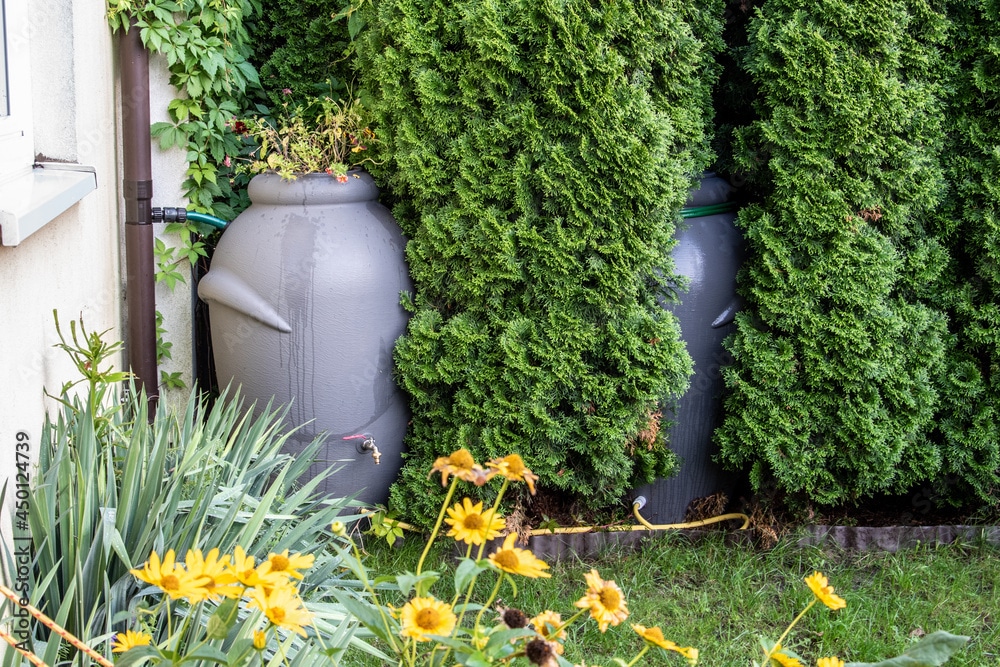Looking for rain barrels rebates, cistern discounts, or money back on your stormwater utility fees?
Find all local incentives in your area that will reward you for your rain capture.
It has only been within recent years that people have become more aware of the benefits of water capture systems. Rainwater harvesting tanks provide a sustainable source of water while serving as an efficient resource management tool. Explore the types of rainwater harvesting systems to discover the benefits and features of each, so you can decide which type is right for you.
Water is a commodity that we often take for granted. It has become such an integral part of our lives and it is just there, always available when you turn on the tap. Unfortunately, some of us can not say the same about access to clean water or safe drinking water. As water scarcity and water quality become more publicized and/or more prevalent, capturing falling rain gets more visibility. That’s because rainwater harvesting just makes sense.
In addition, these simple solutions also decrease stormwater runoff. Rainwater can easily be used in homes for non-potable purposes. It’s also very practical for garden irrigation, livestock, fountains, and ponds.
Hopefully, the following information will help you understand the pros and cons of each system and where they work best. If you’re just looking for the quick and dirty on what’s appropriate for you, scroll down to the conclusion. But if you’re looking for more after reading more you’re interested in exploring those options feel free to use our free tools to organize the project and get connected to a local expert.
Rainwater Collection System
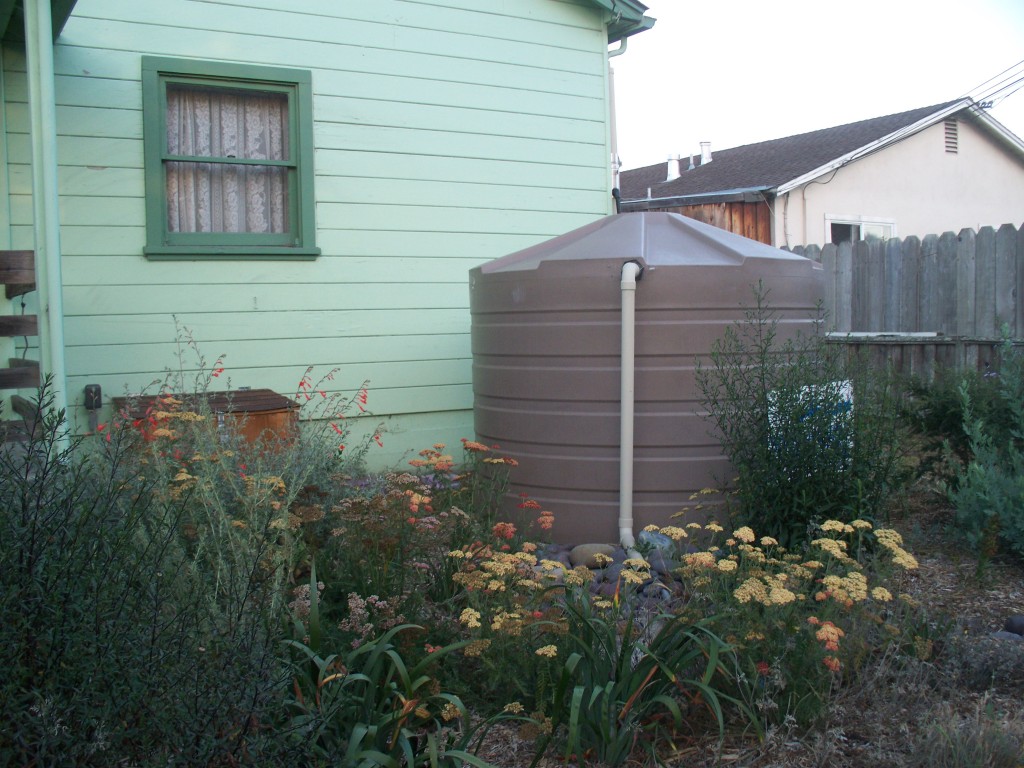
Rainwater collection systems can be classified into three types: rain barrels or rainwater tanks that are connected directly to the downspout outlet of the gutters; cisterns which are reservoirs buried underground or elevated above ground with a roof structure over the top; rain gardens which are formed by digging out natural grade depressions in order to hold rainwater for later use.
These types vary in size from large-scale systems for villages or towns down to small-scale household rainwater harvesting systems. While rain barrels are simple devices, historically, cisterns and rain gardens can be quite complicated and expensive to construct without a qualified professional. Nevertheless, there are definitely cases where cisterns and rain gardens make the most sense for a particular stormwater situation.
Now I know we just mentioned rain gardens, in the interest of being thorough. These marvels of the gardening world are an endeavor unto themselves, so the focus of this article is specifically on rainwater reuse systems – rain barrels and cisterns.
You can read more about rain gardens here.
Below is a description of each method of rainwater harvesting so that you can evaluate what might be a good fit for you.
Rain Barrels
Often called the “gateway drug” of green infrastructure, rain barrels are usually the easiest option for property owners to start implementing stormwater management on their land. This rainwater harvesting technique was introduced to reduce the amount of rainwater runoff, especially during heavy rainfall events when rainwater flows from downspouts directly into storm drains.
These systems are great for both flood protection (in heavy rainfall regions) as well as for use to irrigate gardens and landscaping.
How Rain Barrels Work
Rain barrels catch and store rain that falls within a certain area or “catchment area.” Typically a catchment area corresponds to the roof area where rainwater falls. Rain barrel(s) are connected directly to gutters in order to catch and store rainwater runoff from a single downspout or multiple downspouts, accumulating water for later use.
Your Best Rain Barrels for Water Capture
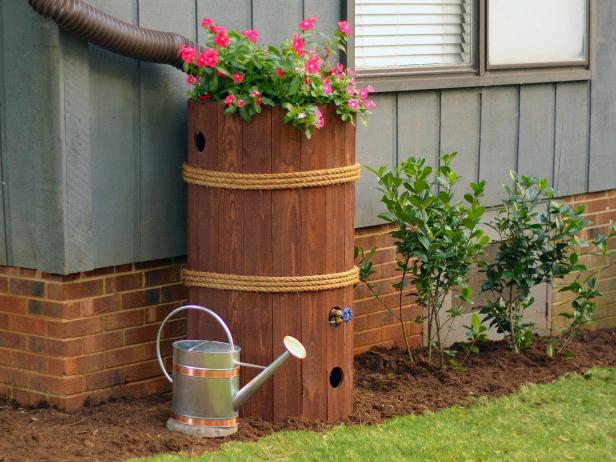
Rain barrels come in numerous designs and sizes depending upon where you live and how much rainwater harvesting is needed. They can range from small 50-gallon rain barrels up to large 500-1000 gallon tanks. Most municipal rebates for rain collection hardware require a barrel size or system capacity of 500 gallons
This collection method consists of a container connected to the gutter downspouts by a flexible hose. Usually, there is a lid and a spout so that it can be easily opened and so that the rainwater can actually be used. As. a best practice, every rain barrel should have an overflow outlet at its highest point in order to prevent the barrel from overflowing and allow proper drainage.
As part of a stormwater management ecosystem, especially in heavy rainfall areas, a connection port allows a flexible overflow tube to send excess rainwater runoff to a cistern below ground level, or a rain garden somewhere on the same property.
Types of Rain Barrels
Rain barrels are one of the most accessible options for stormwater management because there is a spectrum of possibilities when it comes to installation: rooftops rain barrels, underground rain barrels, basement rain barrels, vertical rain barrels, self-contained rain barrel units (consists of a water pump or other components), rainwater tanks; even hybrid systems where rainwater flows into multiple containers.
If you are thinking about purchasing a rain barrel for use on your property, make sure that you use our free tool to search for incentives in your area. All you have to do is put in your property address to view a list of possible rebates, grants, and financing options.
Cisterns
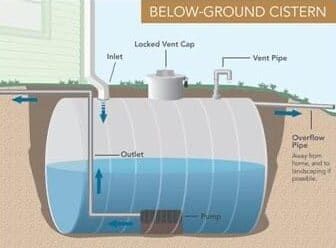
The space around the cistern can either be enclosed or semi-enclosed by walls of cement blocks/concrete brick so it is separated from the surrounding environment while allowing them to breathe (to reduce the risk of rainwater harvesting system mold growth and damage due to rainwater tank neglect).
How Cisterns Work
Cisterns hold rainwater runoff from rooftops, parking lots, driveways, patios, and other impervious surfaces for later use. While the actual catchment system is very similar to rain barrels there are some pretty notable differences between cisterns and rain barrel systems. We’ve put together a page full of infographics on rainwater harvesting systems and more. Take a look at your convenience!
Cisterns often collect water on a larger scale and can include much more complex options for water filtration and for the supply of water. Harvested rainwater may also be treated with chlorine or ozone gas to sanitize it for other uses. In the event of household use, typically, a cistern will be installed on the roof of a structure supplying water for day-to-day use.
This is not the most common use case, but it’s definitely worth mentioning. Compared to cisterns, rain barrels are relatively simplistic but perfectly suitable for most homes.
In most cases, a cistern is installed in or on the ground. That being said, it functions very differently from a well. The essential difference is that wells are connected to the local groundwater. Alternatively, a cistern has a waterproof enclosure and functions reservoir, securing rainwater and keeping it accessible for reuse.
Cistern Construction
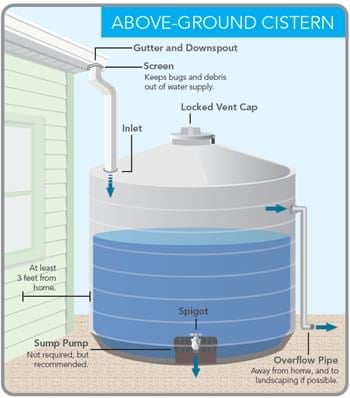
In larger installations, multiple tanks are connected together to form large rainwater harvesting systems that feed into one common holding tank located below ground level. A cistern can serve multiple functions depending on the number of rainwater collection systems installed, along with how many storage tanks are located in the cistern.
Cisterns date back before medieval times and can be made out of almost anything. They are truly only limited by the creativity of the human mind. Although charming design choices are highly subjective and questionably sound, ideas range from an old-school repurposed water pump to full-blown water features.
Many countries have implemented the use of cisterns are a requirement for all new construction, just highlighting their usefulness in an organizational setting.
The Final Word on Rainwater Harvesting
Collecting rain that falls on your roof and your land is really a no-brainer; especially since (in most cases) you can get a significant portion of your out-of-pocket expenses reimbursed by a stormwater incentive.
All of the options discussed above contribute to:
- improved water quality in your community,
- reduced stormwater runoff,
- leverage nature’s bounty and,
- increase your property value.
Cisterns are great for larger water needs, especially when interested in treating the water for applications other than gardening and irrigation. Rain barrels are the easiest to roll out for general household use. If you have a green thumb, want to beautify your home, or are looking to resolve a situation of pooling water in your yard a rain garden might be the right choice.
Now that you know a little more about systems to retain rainwater, you can use your property address to explore available incentives in your area using our free search engine on myrainplan.com.


